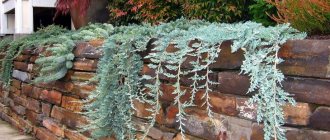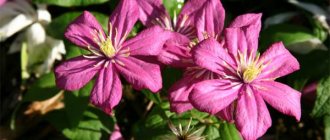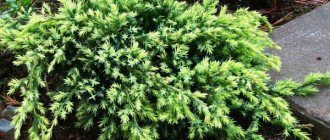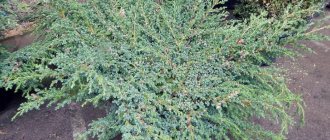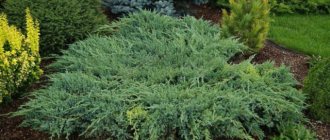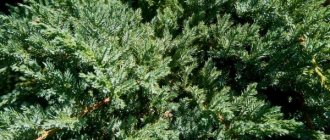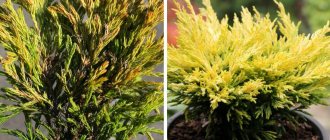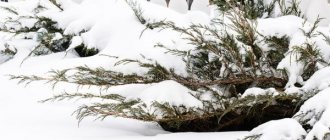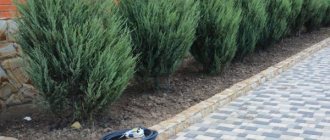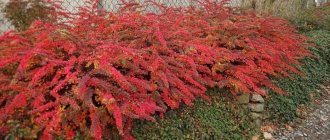Loading…
Loading…
Juniper Blue Carpet is an evergreen coniferous shrub. It is characterized by a highly branched crown of a flat shape. The variety got its name from its silver-blue needles. Under favorable growing conditions, it can produce dark blue berries. Read about horizontal juniper!
Juniper Blue Carpet: description, photo, main information
Juniper Blue Carpet: description, photo
Juniper is an evergreen, coniferous, shrub and tree crop from the cypress family. There are approximately one hundred different varieties around the world. They can decorate any garden, whether with a limited territory or an unimaginably vast one.
Briefly about the real variety
Juniper, blue carpet or blue carpet is a coniferous, permanently green plant. Breeders called this variety blue carpet because it has fairly thick needles and they lie close to the ground, and the color is blue with a silver tint; the pine cones on the plant are dark blue. In the wild, juniper can be found in China and Taiwan on mountain slopes. Further in the article you will learn everything you need about Blue Carpet juniper. How it can be used in various compositions, what plants need care and how to plant it correctly.
Diseases and pests
- Trachiomycosis. The reason is stagnation of water in the soil and high air humidity. At the initial stage it spreads to the root system, and subsequently affects the entire plant. The essence of the disease is the blockage of the tufts through which the juniper receives nutrients. At the first symptoms, expressed in the appearance of dry branches, the affected segments are cut off with pruning shears and the green mass is treated with a fungicide. It would not be superfluous to carry out prophylaxis of young specimens with such drugs as Maxim, Fitosporin.
- Drying of branches. Somewhat reminiscent of trachyomycosis. However, in this case, the disease is accompanied by the formation of small brown or black growths on the surface of the bark. The disease can be prevented by systematic sanitary pruning and treatment with copper sulfate at a concentration of 1%.
- Rust. Occurs in connection with the activity of basidiomycetes. Symptoms include deep orange growths on branches. As a result, there is a decrease in decorativeness and the death of the plant. The problem is solved by spraying Arceride 4 times with an interval of 8-10 days.
Among insects, we especially like the scaly bush of spider mites, leafminer moths, aphids, and scale insects. Regular treatments with Fitoverm or Karbofos will help get rid of annoying pests.
Juniper scaly Blue Carpet. Description.
Juniper scaly Blue Carpet. Brief overview, description of juniperus squamata Blue Carpet
Juniper scaly "Blue Carpet" | Plante.md
Juniper Blue Carpet: description, photo, variety presentation
Juniper Blue Carpet: description, photo
Let's consider the characteristic features of this variety.
This is a scaly juniper that was developed in Holland at the end of the twentieth century. In nineteen seventy-seven it was officially recognized and the variety received a gold medal at an international exhibition.
The variety is well suited for cultivation in temperate climates, including the European territory of the Russian Federation.
The variety is represented by a creeping shrub, that is, located directly near the ground, which forms dense bluish thickets.
There are about sixty-five species of this shrub and they differ in radiance from each other.
Blue carpet differs from other junipers in that its needles are blue and soft and scaly.
The shoots grow parallel to the surface of the earth and adhere quite closely to each other.
Cone-berries of a dark blue color appear on the plant towards the end of August.
The taste of the berries is very bitter, it is not recommended to eat them, the aroma emanates from them is pleasant and spicy.
Description
Scaly juniper Blue Carpet is a low plant reaching only 30-40 centimeters. However, the bush is quite spreading and can occupy an area one and a half to two meters in diameter. In some classifications, by the way, it is listed as horizontal.
This is an evergreen plant with a flat-growing, ground-cover type crown. The variety was developed in Holland in 1972. This is a real long-liver - planted in a good place and with careful care, the plant can live 200 years or more. Ephedra is very unpretentious and shows remarkable resistance to the vagaries of weather and climate. Moreover, it is growing quickly.
External description
Blue Carpet juniper is famous for the unusual color of its needles - pale blue (see photo). The needles, pointed at the end, grow 1 cm in length. The crown is formed like a pillow, spreading widely parallel to the surface of the earth. The crown grows by about 8 cm per year. The plant produces fruits - these are dark blue cones with a waxy coating, characteristic of juniper.
Please note that the sap of the plant is poisonous, so when working with it it is recommended to wear gloves on your hands and protect your face with a mask.
Application
The plant is loved by landscape designers and is highly valued by them. Often images of Blue Carpet juniper can be found in various books, brochures and glossy magazines dedicated to garden decoration. Coniferous shrubs are very popular due to their pronounced decorativeness, versatility of use, and unpretentiousness. It can be used in garden design in a wide variety of ways.
Often mono-compositions are formed from several copies. Such groups look very impressive, but there is a minus - it is inconvenient to mow the lawn around them. In order to care for the site properly and comfortably, it is better to plant Blue Carpet juniper in groups with other conifers.
In addition to coniferous plants, such compositions can also include deciduous, herbaceous, and even flowering plants:
- roses;
- bulbous;
- geraniums
It is important to maintain a distance between plants so that they do not suppress each other.
Since this juniper has a creeping, ground-cover form, it is used in landscape design to decorate and strengthen slopes and rocky areas. The conifer will look good both on an alpine hill and in a rock garden.
Shrubs are also widely used in landscaping city parks and streets. Since this type of juniper is resistant to polluted air and harmful emissions, it does quite well in the most polluted places of the city. In addition, it can easily be given an artistic form and made a real decoration of the surrounding landscape.
Juniper scaly Blue Carpet: growth
Juniper scaly Blue Carpet
Let's consider the growth features of this variety.
After ten years have passed after planting, the plant reaches a height of thirty to thirty-five centimeters.
The width of the bush is usually one hundred and ninety to two hundred centimeters.
When the plants become fully mature, their growth reaches almost a hundred centimeters, and the width of the plant expands to six hundred centimeters.
The needles on this shrub are five to six millimeters in length.
It is believed that Blue Carpet is one of the most compact species of scaly junipers.
The smallest representative of this variety is squamata Blue Carpet roses, up to only half a meter.
And the tallest Blue Carpet bonsai can reach a height of sixteen hundred centimeters.
Brief description of the plant
Juniper has a light, undemanding nature, and therefore is popular with designers and private homeowners. The Blue Carpet juniper got its name because of the color of its crown - silver-blue. And the fruits of the bush are thick blue, with a waxy coating.
The needles of this plant variety are up to 1 cm long, pointed, needle-shaped. The crown grows with a diameter of more than two meters, an adult Blue Carpet is 50-60 centimeters in height, and over the course of a year it gains up to 5 cm in height.
The birthplace of scaly juniper is considered to be China, or rather, its mountainous regions - the Eastern Himalayas.
There are 70 plant species. Blue Carpet belongs to the family of cypress ornamental shrubs.
We can give a general description of this variety of scaly juniper:
- Prostrate crown up to 60 cm high, up to 2.5 m in diameter;
- Life expectancy up to 50 years;
- Silver-blue, short, up to 1 cm, needle-shaped needles;
- At any time of the year, the color of the needles and the shape of the crown of the bush do not change, which makes Blue Carpet quite popular in design projects;
- Slow annual growth - the bush adds less than 5 cm in height and width, which is also appreciated by lovers of decorative, picturesque plants;
- Photophilia;
- The plant does not require regular watering and grows well in almost any soil;
- It tolerates low temperatures well without losing its charm. Blue Carpet successfully coexists with garden geraniums, roses, tulips, daffodils, and many more flowers. It looks great in a group of other herbaceous, deciduous or coniferous plants.
How juniper survives winter
Let's consider the wintering features of this variety.
Juniper is considered fairly rose-resistant, but it requires proper care.
Since there are strong winds and quite severe frosts in winter, the needles may begin to break.
The negative influence of weather factors in winter may lead to the extinction of needles.
That is, the branches cease to be blue, become more brown, and in a short time the bush gradually dies.
To protect the plant, you need to cover it.
How fast does this variety grow?
Let's consider the features of the growth rate of this variety.
Junipers are long-lived.
The average lifespan of a juniper is about three hundred years.
If we compare the growth of a bush and its age, then the first occurs quite quickly.
Growth lasts up to seven years, and on average the shrub grows eight to nine centimeters per year.
The plant loves light, and its lack can affect the growth rate of the plant - the juniper will simply grow more slowly.
To prevent growth from being too slow, it is necessary to feed the plants correctly.
What does blue carpet juniper smell like?
Let us consider the characteristic aromatic features of this variety.
The smell of pine needles is very pleasant, but pungent.
Gardeners have recognized that the scent of this plant has healing properties.
If you smell the pine needles, you can strengthen your nervous system, relieve headaches, and also cure some diseases associated with the breathing process.
The smell may also help get rid of insomnia.
Plants secrete special phytoncides that purify the air and help treat certain diseases.
Interesting. In ancient Rus', it was customary to burn juniper branches and fumigate the room, especially if there were sick people in them, this helped prevent the spread of the disease. Since this shrub is medicinal, it can be seen in the territories of various boarding houses and sanatorium areas.
Application of Blue Carpet by landscape designers
Let's consider the characteristic features of using this variety in landscape design.
This variety is very popular among landscape designers; it is unpretentious and quite easy to care for.
Also, shrubs of this variety tolerate various methods of shaping well, and after pruning the crown only becomes denser.
These are truly ornamental plants, and they are very often used to decorate squares, parks, personal plots and vegetable gardens.
On various sites related to landscape design, you can also very often see representatives of this variety.
Blue Carpet looks good against the background of a lawn.
The only disadvantage of such compositions is that it is very inconvenient to mow the lawn around the juniper, since it is creeping.
A good combination is flowers plus scaly juniper.
But in this case, it is important to correctly calculate the distance between plants so that they do not interfere with each other’s proper development.
Blue Carpet looks very good on various slopes.
This variety is almost ideal for decorating an Alpine Hill or rock garden.
You can also often see this variety of juniper around home ponds.
Creeping plants prevent landslides, so blue carpet is often planted on slopes.
Since the blue carpet variety tolerates polluted city air well and can be shaped, it is often used to decorate city parks and public gardens.
It can also be planted as a container crop.
Use in landscape design
Scaly juniper Blue Carpet is a favorite of landscape designers because of its appearance and low maintenance requirements.
It can be found in a variety of plantings.
- Single groups. Several plants are planted, which over time grow into a real blue carpet. In this case, they are isolated from others so that the Blue Carpet gets all the attention. The disadvantage is that it is inconvenient when mowing the lawn.
- Decor of ponds and paths and roofs.
- Combination of junipers. With this variety, taller trees are used, which are planted behind. The result is a gradual transition from a creeping plant to an erect one.
- Complex compositions. Coniferous crops and deciduous shrubs are mixed. You can use herbaceous perennials and flowers that live one season. In this case, it is important to maintain a distance between plantings so that the plants do not suppress each other.
- Decor of alpine hills, slopes and flat rockeries.
Blue Carpet feels good with roses and garden geraniums. You can plant it next to spring bulbous plants and grass-type ground covers. When planting with peonies and clematis, it is necessary to maintain a distance of at least a meter.
This juniper is used to strengthen the soil on slopes and landscaping large parks in many cities.
Suitable soil for this variety
There are several simple parameters for future soil for juniper. Let's consider several recommendations for soil stratification for this variety.
The area should be well lit.
The soil should not be excessively salty.
Groundwater should not lie near the bushes.
The ideal soil for the Blue Carpet variety is neutral or slightly acidic.
In order for the composition of the soil to be optimal, it is necessary to add:
1) turf land.,
2) peat soil.,
3) coarse sand, in a ratio of one to two to one.
Stagnant water is also not welcome, as are very small and poorly lit areas.
Varietal characteristics
The description of Blue Carpet juniper is as follows:
- bush height 30-40 cm;
- width up to 1.5 meters;
- life expectancy over 200 years.
Juniper juice has toxic properties, so all care work is best done with rubberized gloves.
The main value of the Blue Carpet variety lies in its unpretentiousness and rapid growth.
Rules for planting juniper
There are several simple rules for planting juniper. Let's look at a few recommendations for cultivating this variety.
The plant hole should be larger than its root.
The average normal pit depth for blue carpet is about seventy to seventy-five centimeters. Juniper needs drainage.
The drainage layer should be about twenty to twenty-five centimeters, and it can be made from pebbles, bricks or crushed stone.
Then fill in a mixture of soil from:
1) turf land.,
2) peat land.,
3) coarse sand.
It is necessary to plant the bush so that the neck of the bush sticks out a little, then you need to cover the entire root system with soil.
There is no need to trample the soil; it will gradually settle on its own.
Seedlings should not be located at a distance of less than one and a half meters from each other.
If your plant is not very large, then the distance can be at least half a meter.
During the first week, the juniper needs to be watered frequently.
Blue carpet is best planted in the spring, after the snow has melted.
If the seedlings are planted later, the plant may get burned due to the fact that the sun is already too active.
Waterlogging the soil and excessive watering are detrimental to the plant, it is important to monitor this.
Juniper can tolerate dry periods well.
It can grow in places where there is no constant sunlight.
It is not recommended to cover plantings with snow in winter; snow can break the plants.
A very good place for planting juniper will be an area protected from cold air currents.
Features of planting and proper care
Juniper Cossack Tamariscifolia: description, planting and care
Cultivating this variety of juniper will not be difficult.
First of all, you need to choose the right place for planting it with the following characteristics:
- The area should be well lit.
- The soil should not be saline.
- Groundwater should lie as deep as possible.
In order for juniper to quickly take root, it must be planted in spring or autumn. You need to dig a hole in accordance with the size of the purchased seedling. The soil needs to be prepared - mix one part of sand and turf with two parts of peat.
The planting hole should be two to three times the diameter of the root part together with the soil and about 0.6-0.7 meters deep. First, you need to put 20 cm of drainage into the hole. These can be pieces of bricks or expanded clay with sand. Then expose the seedling and cover it with prepared soil.
In order for the plant to develop and grow well, its root neck should not be deepened.
How to organize watering
How to organize watering
Young bushes of Blue Carpet scaly juniper need to be watered regularly, and adults - only during dry periods, as they already acquire a high degree of resistance to drought.
Important! Sprinkling the juniper crown in the evening has a beneficial effect on the plant.
Another important point in caring for scaly Blue Carpet is the timely removal of weeds. To make this take less time, you need to distribute a layer of mulch around the trunk. You can use gravel, pine chips or bark for this. Every year in the spring it is necessary to fertilize the juniper with a special fertilizer intended specifically for coniferous plants or nitroammophos.
Light level
The bright rays of the sun in spring can harm the coniferous plant, so in the autumn the crown of the Blue Carpet juniper must be covered.
To do this, you can use a special green mesh or white non-woven material. There is no need to protect it from frost, since the plant is frost-resistant with a high degree of resistance.
Pruning branches
Growing the plant requires regular pruning.
- In the spring, it is necessary to trim off all juniper branches that for some reason have dried out or are growing in the wrong direction.
- Before covering a juniper bush for the winter, it is necessary to remove all leaves from other trees and shrubs. If this is not done, the crown may begin to rot, and part of the bush may even dry out.
Juniper propagation
All decorative varieties of juniper are propagated by cuttings. To obtain planting material, you need to cut off the lower branch from the bush about 12 cm long, then clear the lower tip of needles and place it in a special solution for 24 hours, which accelerates the formation of the root system. After this, the cutting is placed in a container with peat and sand, tightly covered with film.
Juniper propagation
Containers with rooted cuttings are placed in a shaded place and constantly sprinkled with water, and also ventilated.
If everything is done correctly, then after 1.5 months the cutting will have its own roots. And after three months, the seedlings are ready to be planted in open soil for wintering. Juniper can be planted in a permanent place only after 2-3 years, when its shoots are fully formed.
How to properly water and fertilize plants
Suitable watering regime for this variety.
Let's consider several recommendations for carrying out the watering procedure for this variety.
Young plants need fairly frequent watering and constant watering; when they grow up, they need to be watered only when a period of drought occurs.
The ideal method of watering is sprinkling the needles.
Blue Carpet plants do not tolerate summer heat very well.
They love spraying from a spray bottle and good watering up to twice a day.
To prevent any burns from appearing on the needles, it would be better to water the plants in the evening, when the sun is no longer so strong.
The plant loves light, but direct exposure to strong sunlight can affect its health and the plant may get burned.
To avoid damage to plants, you need to cover the bushes.
In addition to light-colored non-woven material, special green meshes can be used for this.
Aftercare
Juniper Blue Carpet is unpretentious. Caring for it consists of watering, fertilizing, pruning if necessary, mulching and loosening the soil.
Watering and fertilizing schedule
The plant is regularly watered during severe drought; the rest of the time it is content with occasional watering - 1-2 times a week. This rule applies to adult plants, but young, recently planted and actively growing bushes will need more water; they need to be watered more often, in hot weather - every other day.
A simple rule applies here - it is better to water rarely, but abundantly, than often and little by little. Blue Carpet juniper cannot be flooded - it will not tolerate stagnation of water at the roots. But he likes spraying with clean water in the mornings or evenings.
Feed the shrubs in the spring with complex fertilizer for conifers. If a young seedling is noticeably stunted in growth, nitrogen compounds or nitroammophoska are added.
Pruning juniper Blue Carpet
In most cases, Blue Carpet horizontal juniper does not need pruning. Only dry, damaged or diseased branches are removed.
When planting in groups with deciduous trees and shrubs, you need to ensure that litter does not remain in the crown of the “Blue Carpet”, otherwise rotting leaves can damage the needles or even cause disease.
Mulching, loosening the soil
After planting and watering, as well as before wintering, the space under the creeping branches is loosened superficially so as not to touch the roots, and mulched generously. For this purpose, use pine bark, pine scree, rotted high-moor peat, wood chips or small gravel.
Mulching performs a dual function - it protects the soil from drying out and compaction, and also prevents the growth of weeds. This is very important, because weeding creeping thickets of prickly juniper is extremely troublesome.
Preparing for winter
The most common cause of death of conifers and evergreens in the cold season is drought combined with bright sun. Therefore, before wintering, abundant moisture replenishment is carried out, after which the soil is thickly mulched to maintain soil moisture.
If a sunny winter is expected, the plantings are covered with a special mesh or non-woven material such as lutrasil or spunbond. Juniper does not require any additional shelters or insulation.
Only young seedlings are protected in the first winter - they are covered with spruce branches
Juniper Blue Carpet description of fertilization schemes
Let's consider several recommendations for applying fertilizing and fertilizers for this variety.
Feeding will need to be done in May or April.
For spring fertilizing, a fertilizer such as nitroammophoska or mineralized complex fertilizers is suitable.
In order for the plant to receive the necessary supply of nutrients for the winter, it will need to be treated in the fall with fertilizers containing potassium and phosphorus.
In order for young plants to feel good and quickly take root, it is necessary to periodically loosen the soil next to them.
Using mulch and loosening
Let's consider several recommendations for loosening and mulching for this variety.
As mentioned above, loosening is necessary for young seedlings, as well as weeding from weeds.
After the shrub has been planted, it is necessary to cover it with mulch.
Peat is used as mulch; the layer height should be about nine to ten centimeters.
To prevent the root collar of shrubs from rotting, it is recommended to remove the mulch in the spring.
To prevent damage to the upper fragile roots of the plant, loosening should be done very carefully and not deeply.
Mulching the circle around the juniper helps prevent moisture from evaporating too quickly.
In addition, mulch helps reduce the number of weeds that prevent the plant from developing properly.
Humus and compost are used as mulch; you can sprinkle a layer of bark or sawdust on top.
Cones and needles of other trees are also applicable.
The height and layer of mulch should be about five to six centimeters.
How to care
We will find out further what kind of care Blue Carpet juniper needs.
Watering
In this case, soil moisture needs to be systematic and regular - especially after planting a young plant. When juniper becomes an adult, it no longer needs frequent watering - the soil will only need to be moistened during periods of extreme heat and drought.
However, at any age during the summer heat, the shrub responds very well to external spraying of the crown with water. For procedures, choose a time in the evening or morning to avoid pine needle burns.
Top dressing
The plant is fertilized annually: we recommend using special fertilizer for conifers for this purpose. If it was not possible to get specialized fertilizer, you can use nitroammophos for the next feeding.
Weeding, loosening, mulching
Regularly remove weeds from the area around the juniper. In addition, it is recommended to periodically mulch the soil so that moisture is better retained in the soil. Use pine bark, sawdust, gravel or peat as mulch.
Protection and wintering
If the plant is planted in full sun, it may suffer from aggressive midday rays. To protect the needles from burning out in the spring, gardeners cover the shrubs with white non-woven material or green mesh in the fall.
In cold seasons, the plant does not require additional protection; it tolerates frosty winters quite well. The exception is in regions with little snow and very frosty winters: in this case, you can cover the juniper with cardboard sheets or agrofibre or burlap.
Young squamata need winter shelter regardless of the climate of the region. Protect the shrub from freezing for at least the first couple of winterings. Please note that as a result of freezing, the plant’s needles acquire an unattractive brown tint.
In the fall, make sure that fallen leaves from taller plants do not remain on the branches of the bush. The fact is that in winter the leaves can become damp and rot, which will lead to damping off of the juniper shoots. Remove all foliage.
Trimming
This plant does not require crown formation. However, if sick, dry, or broken branches appear, it is necessary to carry out sanitary pruning and rid the bush of a possible source of infection. Typically, sanitary pruning is carried out in the spring after a thorough inspection of the plant.
Protection from pests and diseases
More often than other diseases, Blue Carpet juniper is affected by rust. The drug Arcerid, diluted according to the instructions, will help cope with the scourge. To completely get rid of rust, it is necessary to spray the bush in four doses with a ten-day interval.
Among the pests that can affect juniper:
- scale insect;
- aphid;
- spider mite.
Sometimes the leafminer moth also joins this group of insects. Cope with pests as follows:
- aphids are sprayed with “Fitoverm” - in two doses with a two-week interval;
- moths are destroyed with “Decis” - spraying according to the same scheme as above;
- spider mites can be removed using Karate;
- The well-known Karbofos will protect juniper from scale insects.
We learned how to properly plant Blue Carpet juniper in the garden and how to care for this plant. Take full responsibility when choosing a place to plant this plant - after all, the shrub can live for more than two hundred years. With proper choice of site and proper care, Blue Carpet juniper actively develops and delights with its beauty.
How to form Blue Carpet
Let's consider several recommendations for the formation of this variety.
Frequent pruning of shrubs is not required; it is only needed in the spring.
Spring pruning is needed to remove branches damaged in winter, as well as modified shoots.
If your juniper grows in close proximity to deciduous trees, you need to ensure that no leaves remain in the needles.
The leaves in the needles may begin to rot, and this can cause disease and damage to the juniper.
Juniper Blue Carpet description of preparation for winter
The plant can survive temperatures down to minus twenty-nine degrees. Let's look at a few recommendations for preparing this variety for the winter.
When the plant is only a year old and when it is young enough, it needs to be covered.
Under very unfavorable conditions, the plant may die in winter, and due to severe frosts and wind, the needles may become a different shade.
In order to prevent such consequences, it is necessary to protect the juniper in the fall.
Protection consists of covering the juniper, as well as mulching the roots with peat.
The mulch layer should be about nine to ten centimeters.
To better preserve the needles, you can glue them with spruce branches.
To prevent the plant from being damaged by strong sunlight after winter, it must be covered with a net.
Juniper Blue Carpet propagation description
Variety Blue, Carpet is represented by dicotyledonous plants. Accordingly, bushes can also have a feminine masculine gender. The type of bush you have can be determined by its external features. In male varieties, the crown resembles an egg and is narrower; in female varieties, on the contrary, it is more widespread over the surface of the earth and is not so dense. In spring, male shrubs, a little coniferous, yellow to me. A cone - berries - appears on female bushes. There are two main ways to propagate juniper: cuttings and seeds. Cuttings better promote the germination of high-quality ornamental plants.
Propagation of this variety using seeds.
Let's look at a few recommendations for propagating this variety using seeds.
The cone berries ripen by September.
The diameter of one berry is on average seventy-five to eighty millimeters.
As the buds mature, they change color from green to dark blue, and a slight whitish coating appears on them.
Three seeds are found inside the berry, and they can be used to propagate the plant.
In the autumn, the seeds should be planted in a box and left in a warm place until spring.
Boxes may be exposed to air.
At the end of spring, the seeds must be planted in the ground.
If you plant juniper in this way, do not forget that shoots will appear only a year after you planted the seeds.
Propagation of this variety using cuttings.
A more common propagation method for junipers is through cuttings. Now you will learn how to do this. Let's look at a few recommendations for propagating this variety using cuttings.
From the grown bush it is necessary to divide cuttings, the length of which is about eleven to twelve centimeters.
The coniferous branches that are located below must be cleaned.
During the day, the cuttings must be soaked in an aqueous solution with a growth stimulator.
After this, the cuttings can be planted in the ground.
A soil consisting of peat and sand is best suited; this is necessary for better rooting of plants.
Then the cuttings are covered with film, and they must be moved to a dark place.
Regular watering and spraying with water is important for cuttings.
After all cutting procedures have been completed, sprouts may appear in a little more than a month.
In a month, the root system will have time to become sufficiently strong.
Cuttings can be planted in a permanent place, that is, in open ground, three months after rooting.
If desired, you can plant it completely; the plants will be formed in the ground after a few years.
Landing
It is much easier to use a seedling purchased from a nursery.
To plant juniper in open ground, you need to go through three stages: prepare the seedling itself, select and prepare a suitable place and properly care for the plant after the procedure.
Seedling preparation
Juniper needs a lot of light
The easiest to take root are bushes up to 4 years old with a whole lump of earth.
Preparing the seedling consists of abundantly watering the soil approximately 2-3 hours before planting in open ground, so that the earthen ball sets and does not crumble during the procedure.
Preparing the site
To plant needles, choose a place with good lighting. It also grows well in partial shade, although it prefers plenty of light.
The soil is neutral or slightly acidic.
It is important to make sure that there is no stagnation of water in the area: in such conditions, juniper quickly begins to rot and die.
Landing technology
For quick rooting, juniper is planted in the spring, immediately after the snow melts. Planting later may result in sunburn and death.
The planting hole is about 70 cm deep, about 20 cm is occupied by drainage made of brick chips or sand.
In general, the size of the depression depends on the earthen clod: it should be about 3 times larger than it. The optimal distance between juniper and other plants is from 1 m to 3 m.
A little earthen mixture is poured onto the drainage, consisting of:
- peat - 50%;
- turf land - 25%;
- sand - 25%.
After rooting, sprinkle the hole. The root collar is not buried.
In the first week, frequent watering and protection from the wind are required.
What pests and diseases pose a danger to blue carpet
The first possible disease is rust.
Let's consider the characteristic features of a disease such as rust.
The most common disease for juniper is rust, which occurs due to fungi.
Orange growths begin to appear on the needles.
The disease can last for several years, and in this case it is very dangerous for the plants; they gradually begin to dry out and lose their decorative properties.
The second possible disease is trachyomycosis.
Another common disease is trachyomycosis. Let us consider the characteristic features of a disease such as trachyomycosis.
Fungi also act as its causative agents.
The disease occurs when water near the plant stagnates and rot forms.
The disease starts from the roots and gradually spreads throughout the plant.
Essentially, because of this disease, the transfer of nutrients inside the plant stops, and it gradually begins to die and dry out.
If you find dried shoots on your plant, they must be removed to prevent the spread of the disease.
Insect pests.
The most dangerous pest for Blue Carpet is the spider mite, as well as moths and scale insects. It is very important to combat them and apply preventive measures, since they pose a great danger to the culture.
Prevention and treatment
Let's consider recommendations for carrying out preventive and therapeutic measures in the fight against diseases and insect pests.
For a disease such as rust. Spraying the bushes with a solution of arceril will help against the disease. Treatment is carried out four times every two weeks.
With a disease such as trachyomycosis. Fungicides are good for this disease.
When attacked by insect pests. For prevention, plants can be treated with various solutions containing karbofos, karate and decisu. Treatment with these drugs is carried out continuously, once every seven days.
